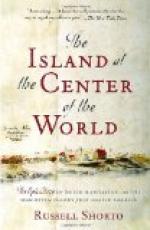New York now became a very active and a very brilliant city indeed, and all manner of improvements were made. The first sidewalks were laid along Broadway, just above St. Paul’s Chapel. They were pavements of brick, so narrow that two persons could scarcely walk along side by side. Then the high hill crossed by Broadway just above the Common was cut away so that the street stretched away as broad and as straight as you see it to-day. Numbers were put on the houses and streets were cut through the waste lands about the Collect Pond, and the barracks which were built for the British soldiers were torn away as unsightly structures. These barracks were log huts a story high, enclosed by a high wall. The gate at one end, called Tryon’s Gate, gave the name to Tryon’s Row as it now exists. Trinity Church, which had been in ruins since the fire, was rebuilt, as well as many, many other houses.
Now the fact that the city was the seat of the national government and was the home of Washington had much to do with its improvement. But New York had only been fixed upon as the capital temporarily, and a dozen States were anxious for that honor. Finally, in the second year that Washington was President, it was decided to build a city which should be the seat of the general government, on land given by the States of Maryland and Virginia for that purpose and called the District of Columbia. While the city (which was given the name of Washington) was being built, the seat of government was to be in Philadelphia, and Washington went there to live. A great many of the gay and brilliant company that had been attracted to the capital followed him there, and for a time New York languished in neglect.
It now began to look as though the United States would be drawn into another war with Great Britain. For the French Revolution was in progress and the French people were at war with the English, and thought that the Americans should help them as they had helped the Americans in Revolutionary times. But President Washington and some of the very wise and good people about him thought it best to have nothing to do with it. So a treaty was made between England and the United States, and the French did not get the help they asked.
Some of the citizens of New York, quite a large number of them, were very angry when they heard of this treaty and burned a copy of it on the Bowling Green, with all sorts of threats. But after a time those who had shouted against it changed their minds. They had something more serious to think of nearer home before many years, for the small-pox broke out in the city and thousands upon thousands hurried away to escape the dread disease. All business was at a standstill, and even the churches were closed. When the scourge had spent its force, it was found that more than 2,000 had died of it.
There was one man who took advantage of the small-pox scare to his own profit. This was Aaron Burr. You will remember him as a boy fighting by the side of Montgomery in Canada. He was now a lawyer known for his great skill the country over; a man of education and deep learning. He was the leader of a political party, a party which contended with, fought with, disagreed with at every turn the party of which Alexander Hamilton was one of the chief leaders.




